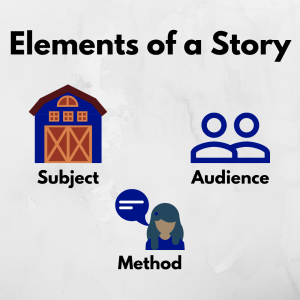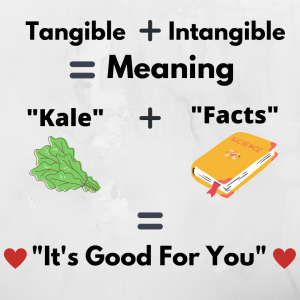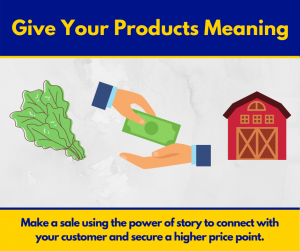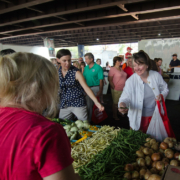Giving Your Products Meaning
 Print This Post
Print This Post
By Daniel Prial, NCAT Community Food Specialist
It’s Not Just About Your Product
Before I was a specialist with NCAT, I was a National Park Ranger at a small historic site in California. Every day, I brought visitors through an old Victorian home and showed them how the folks who once lived in that home were still important today. I connected the visitors to the story of the place and helped them understand how it connected to them personally.
It took me years to realize that professional advertisers do the same thing. They connect a product to a customer through meaning. Think about famous beer commercials that show puppies or horses. Think about telephone companies that advertise families talking over long distances.
 You see, people don’t always behave rationally. And certainly not around the things we buy. We buy products not because they make the most economic sense, but because of the meaning around those products. We buy gendered products, products that fit our age group, or products that align with our social class.
You see, people don’t always behave rationally. And certainly not around the things we buy. We buy products not because they make the most economic sense, but because of the meaning around those products. We buy gendered products, products that fit our age group, or products that align with our social class.
Your customers may tell you that they’re buying your farm product for taste, convenience, supporting their local farmer, etc. They are also buying a means of confirming their own identity and self-image. They want the world to know that they’re the kind of folks who shop local, support a farmer, or enjoy high-quality products.
Your job as a marketer, therefore, is to sell your customers the story, or rather, a meaning they can connect with.
Crafting a Story
In order to successfully tell a story, you need to consider three elements: subject, audience, and method.
- Subject – What are you telling? What is the content? In this case, the subject is your farm, your farm products, and your farm story.
- Audience – Who are you telling the story to? What do you know about them? What do they want to hear? How are your different audiences connected to different products or different facets of your brand?
- Method – How are you going to tell the story? What techniques will you use to convey information about the subject to the audience?
These three elements come together to create a meaning. Every story is a way of talking about meaning, be it: love conquers all, good guys win, or buying local is important. The meaning of your story will build a connection to your audience and help develop a relationship with them.
Making Meaning
Meaning answers the question “so what?” and gives the customer a reason to make a purchase. No matter what you are selling: food, fiber, materials, etc., you need to differentiate yourself from your competitors. Differentiation comes from meaning.
To think about this another way, consider a farmer trying to sell peaches. As a commodity, peaches are less than a dollar a pound and can be found in any grocery store during the right season. Selling peaches through meaning (“locally-grown,” “tree-ripened,” “woman-run business,” “take a bite of summer,” “fresh from your neighbor”) differentiates your product and almost always allows you to command a higher price in the marketplace. Not differentiating your product puts you in the same category as commodity growers who operate on a completely different scale.
One method of creating meaning is to draw out the intangible elements from tangible objects. It’s looking at an object and asking, “so what?” Let’s use kale as an example. As a tangible, kale is a plant of so many inches tall, bitter taste, etc. Not to knock kale too much, but there is a reason why it needed a large marketing campaign: on its own, it easily loses in taste tests to every other brassica, right?
The meaning of kale is important. Kale is:
- The fiber and antioxidants in kale is important in combating diabetes
- The potassium in kale can help combat heart disease
- Compounds in kale will help flush the body of carcinogens from red meat
(Medical News Today, 2020)
Simply put, kale is nutritious. That nutrition is a powerful meaning attached to the product. In addition, the farmer knows that it grows easily, is very hardy, and can be harvested all season. Therefore, it can be an inexpensive source or nutrition.
Your Turn: Make Meaning
Let’s practice this idea. Pick an item from the list and give it some meaning. If you find yourself stuck, make the item more specific. For example, bottle can become beer bottle. You can also think of yourself as a playwright or a movie director. What does it mean if the focus lands on the object for a moment?
- PHONE: __________________________________________
- BOOK: ___________________________________________
- FIRE: ____________________________________________
- BOTTLE: __________________________________________
Phone, for example, can have a lot of meanings: “connection to others,” “connection to assistance,” or “reaching across the miles.” If it’s a cell phone, the meaning can be deeper: “always connected,” “emergency tool,” or “spontaneous meet-ups.” A smartphone has other meanings: “the world in your pocket,” “connecting with grandma over video,” or “time sink.”
Feel free to practice this again with a different object, either from the list or not.
Now, let’s repeat the activity, but with farm products.
- YOUR BROCCOLI: ______________________________________
- YOUR EGGS: __________________________________________
- YOUR GOATS: _________________________________________
- YOUR [Farm Product]: __________________________________
If you find yourself getting stuck, think about what you’d say if you were to make the sale at a farmers market: “Buy my product because…” Your broccoli has meaning because it…
Giving Meaning to the Farm Brand
The farm brand is the story that sits like an umbrella over all of your individual products. It is the personality of your farm, and it affects what you do and how you do it.
When creating a farm brand, the idea is to pull intangibles out of the farm the same way you pull intangibles out of a product to sell it. Working at this level brings out all sorts of complications, however. How do you answer “so what?” for an entire business?
We’ll look more into crafting a full farm brand in a later blog post. The goal is that you can sell the farm brand just like any other product and give your customers a reason to connect to your farm as a whole. This helps them feel loyalty and gives them a reason to come back again and again.
The Story Doesn’t End Here
 Summed up, don’t focus on selling a product. Tell the folks walking by at the farmers market about the freshness of your milk. Tell them about the cancer-fighting lycopene in your tomatoes. Explain how your wool will keep them warm and dry over the winter months. Walk them through the joy they will experience sharing your salsa with their friends.
Summed up, don’t focus on selling a product. Tell the folks walking by at the farmers market about the freshness of your milk. Tell them about the cancer-fighting lycopene in your tomatoes. Explain how your wool will keep them warm and dry over the winter months. Walk them through the joy they will experience sharing your salsa with their friends.
Your products are the means to convey what your customer is really looking for. Give them something to connect with.
If this is something you’re interested in working on, feel free to reach out to me in the NCAT Northeast Office. I’ve got a background in education and a specialty in farm marketing and branding. You can reach me at danielp@ncat.org or by calling 479-587-3471.


 USDA photo by Lance Cheung
USDA photo by Lance Cheung



 USDA Photo by Lance Cheung.
USDA Photo by Lance Cheung. 


